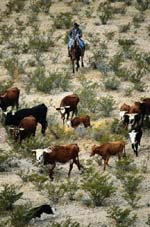
| Search Oregon-Bioscience.com | |
BioFact:
(1968) The FAO creates a Crop Ecology and Genetic Resources Unit to act as a clearinghouse for information on plant collecting expeditions.
Invest Northwest, CEO & Investor Forum March 22-23, 2004...Sign up now!
History
Economy/Cost of Living | Education | Recreation & Entertainment
Transportation | Suggested Reading List
 Thirty years after the Lewis and Clark Expedition camped along the Columbia River in the autumn of 1805, near what today is the Portland International Airport, traders, missionaries and settlers began arriving from the 24 United States. In the 1840s, this trickle became a flood as thousands of immigrants traveled 2,200 miles (3,520 km) by covered wagon from Independence, Missouri, to Oregon City, just south of present-day Portland. From 1843 to 1870, a quarter of a million people traveled the Oregon Trail, most of them settling in the lower Willamette Valley.
Thirty years after the Lewis and Clark Expedition camped along the Columbia River in the autumn of 1805, near what today is the Portland International Airport, traders, missionaries and settlers began arriving from the 24 United States. In the 1840s, this trickle became a flood as thousands of immigrants traveled 2,200 miles (3,520 km) by covered wagon from Independence, Missouri, to Oregon City, just south of present-day Portland. From 1843 to 1870, a quarter of a million people traveled the Oregon Trail, most of them settling in the lower Willamette Valley.
In 1845, after acquiring a claim to 640 acres on the west bank of the Willamette River, Amos Lovejoy of Boston and Francis Pettigrove, a merchant from Portland, Maine, plotted four streets, then flipped a coin to name their new town. Pettigrove won, and the site was named Portland. From the beginning, Portland was a thriving seaport and trading center. Within a decade, the town boasted a sawmill, The Weekly Oregonian, and almost a thousand residents.
During the 1850s, farmers and foresters near Portland capitalized on the demand for food and timber generated by the California gold rush. Buoyed by this trade and a rapidly growing population, Oregon became the nation's 33rd state in 1859. Portland was already one of the wealthiest towns in the nation when the transcontinental railroad reached the city in 1883, generating a new period of economic growth in the Willamette Valley.
for food and timber generated by the California gold rush. Buoyed by this trade and a rapidly growing population, Oregon became the nation's 33rd state in 1859. Portland was already one of the wealthiest towns in the nation when the transcontinental railroad reached the city in 1883, generating a new period of economic growth in the Willamette Valley.
By 1900, Oregon was the nation's third-largest timber producer. Portland's population was 95,000 and, five years later, the Lewis and Clark Centennial Exposition attracted more than a million tourists to the city. The population doubled over the next decade.
A new business and population boom took place in Portland during World War II, when 160,000 people were employed building ships. After the war, the region's timber industry again boomed, keeping pace with the nation's peacetime housing boom.
Today Portland enjoys a healthy, diverse economy with a broad base of manufacturing, distribution and international trade, a diversity that creates a stable business environment.
Related Resources
Print Page

